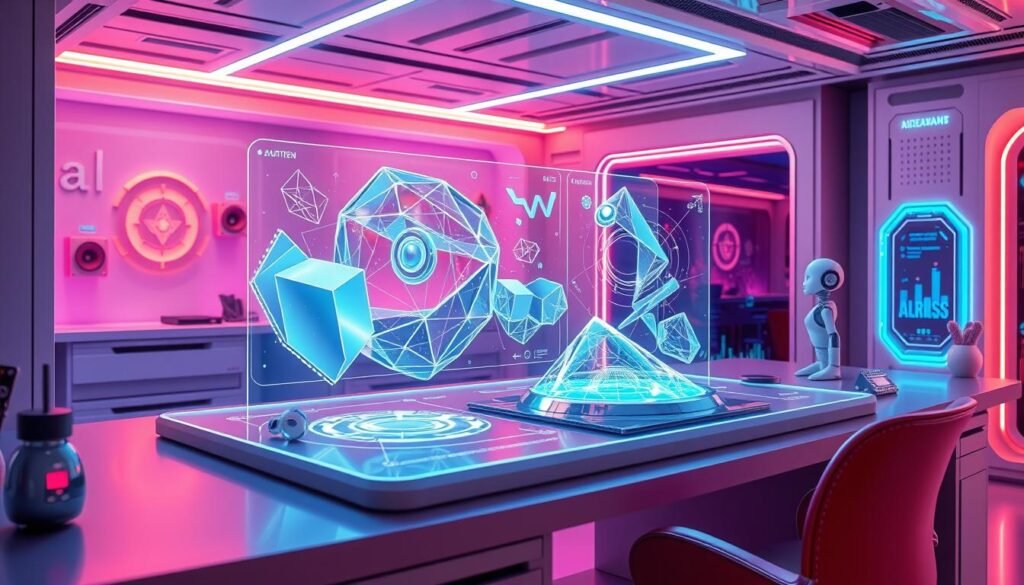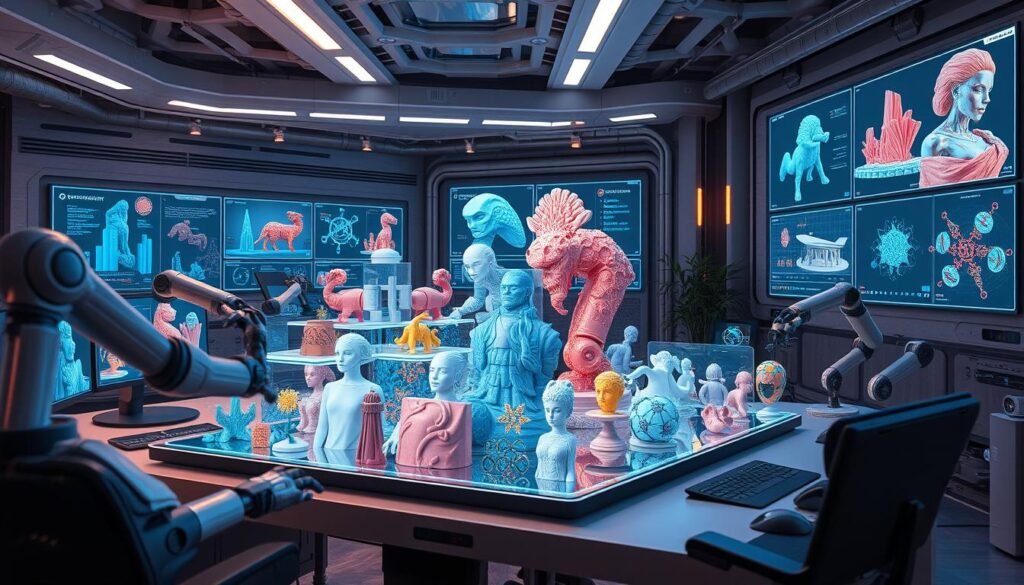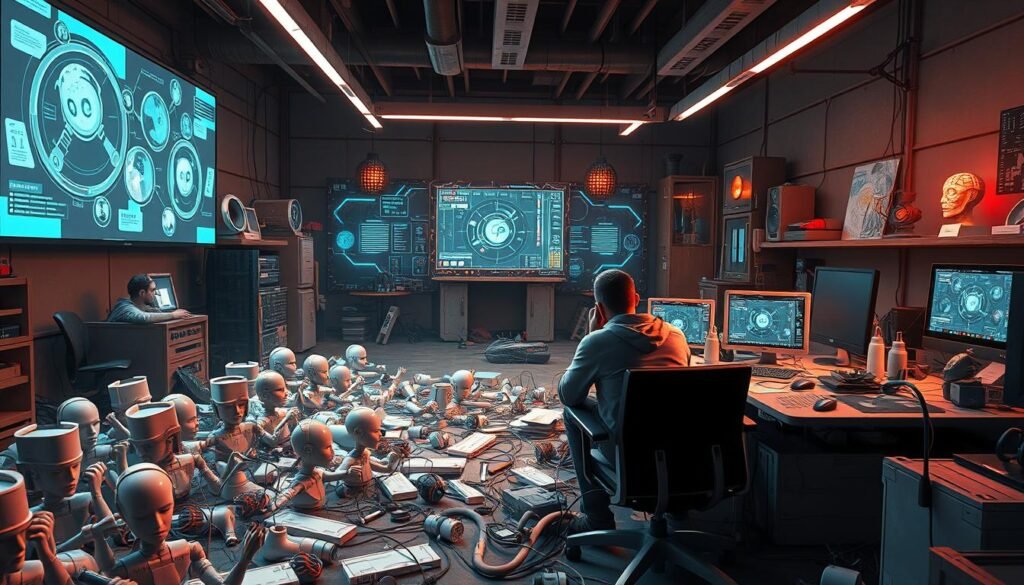Did you know that the need for top-notch 3D models has skyrocketed? This is thanks to tech progress and the boom in online shopping. Now, fields like architecture, entertainment, and healthcare are turning to AI for 3D modeling and rendering1. AI is not just changing how designers work. It's also making the whole process more accurate and faster2.
Big names like NVIDIA, OpenAI, and Autodesk are at the forefront. They're creating tools that use AI to make workflows smoother and improve quality2.
In AI rendering, we've seen big steps forward. Tools like generative modeling can make 3D models on their own, based on what you need2. As more industries use AI, favorites like Blender, Autodesk Maya, and Unity are becoming go-to choices. They give designers powerful tools to be creative3.
As AI keeps getting better, it will change how we work with design. It's an exciting time to explore 3D modeling and rendering.
Key Takeaways
- • The demand for high-quality 3D models is increasing across various industries.
- • AI improves the accuracy and efficiency of 3D modeling and rendering workflows.
- • Generative modeling allows for autonomous creation of 3D models.
- • Leading tools in the industry include Blender and Autodesk Maya.
- • Integrating AI will continue to enhance creative capabilities in design.
The Evolution of 3D Modeling and Rendering
The history of 3D modeling started in the early 1960s. Ivan Sutherland created Sketchpad, the first CAD program4. This breakthrough opened doors for growth in fields like architecture, engineering, and entertainment4. Today, software like Blender and Maya has greatly influenced 3D Rendering History4.
3D modeling is now key in medicine for making surgical models and prosthetics4. It also helps in education by making complex ideas easier to understand4. Scientists use it to study issues like climate change4. Yet, technology still faces challenges, like hardware crashes, showing the need for ongoing improvement5.
New rendering tools, like NVIDIA’s DLSS 3, have made a big difference6. They speed up rendering, making 3D modeling smoother6. AI is also changing 3D Rendering History by making things more efficient and realistic5.
Understanding 3D Rendering
3D rendering turns complex 3D models into realistic 2D images. It uses techniques like textures, lighting, and materials to add detail. This process is key in many fields like architecture, gaming, and film.
It helps in creating clear visual content and spotting design problems early. For example, it makes architectural blueprints detailed and textured. This helps in understanding design elements and spotting issues7.
Defining 3D Rendering and its Applications
3D rendering creates 2D images from 3D scenes. It uses software like Blender and V-Ray to make visuals look real. This helps in better communication and understanding between artists and clients.
There are many techniques used, from quick 2D visuals to detailed ones. Tools like Adobe Dimension and NVIDIA use AI to improve quality and speed8.
Distinction Between 3D Modeling and Rendering
3D modeling creates the shape of objects, while rendering adds life-like elements. Techniques like scanline and ray tracing are used to make images detailed. AI technologies help in making the process faster and better without losing quality.
Knowing the difference between 3D modeling and rendering is crucial. It helps in effective design execution7.
The Role of AI in 3D Modeling and Rendering
Artificial Intelligence is changing how we do 3D modeling and rendering. AI helps automate tasks, letting you focus on creative ideas. For example, AI can make textures faster, making your work more efficient9.
Nvidia’s Instant NeRF technology is a big leap. It turns short videos or images into detailed 3D scenes. This shows how AI is boosting your 3D work10. Flowframes software also upscales 3D materials, improving your renderings10.
AI speeds up making 3D models, unlocking your creativity. It can create many model versions, sparking new ideas9. AI also makes virtual and augmented reality better, making them more useful9.
Exploring AI in rendering and modeling reveals a changing world. This change brings both challenges and opportunities to the 3D design field. While AI might replace some old methods, it could also lead to new, better ways of working10.
Artificial Intelligence in 3D Modeling: Current Applications
AI in 3D Modeling is changing how designers and architects work. It brings tools that make their work more efficient. AI-driven Design Automation lets you focus on creativity by automating tasks.
AI can take over 3D modeling tasks, giving you time for creativity11. This technology makes design work easier and opens up new ways to improve your projects.
AI-driven Design Automation
The age of AI-driven Design Automation brings powerful tools to your workflow12. These tools, like Autodesk Maya and Blender, use algorithms to boost your creativity. They make modeling faster and more accurate.
AI also makes 3D models more precise, which is key for 3D printing and virtual reality11. This means less chance of mistakes, allowing for detailed designs. AI also improves lighting and texture in your scenes12.
Real-time 3D Modeling Solutions
Real-time 3D modeling is changing design validation. AI helps create new shapes and textures, like for plants and trees11. This makes prototyping faster and feedback quicker, which is crucial in development.
Modern AI uses machine learning to improve rendering and visual quality13. Tools like NVIDIA Omniverse and Adobe Dimension show how AI can enhance rendering and speed up production13.

AI Technologies Transforming Rendering Techniques
The world of 3D rendering is changing fast, thanks to AI. Machine Learning in 3D Rendering is key to better quality and speed. Now, tools like Convolutional Neural Networks (CNN) help analyze 3D data, making results more real and reducing manual work.
Machine Learning in 3D Rendering
Machine learning has made 3D rendering faster and more accurate. For instance, NVIDIA Omniverse uses AI to speed up rendering, ensuring top-notch visuals in 3D projects14. Unity and Unreal Engine also use these algorithms to make characters smarter and lighting better in real-time14. This lets designers create detailed, immersive worlds more quickly than ever.
AI-powered Upscaling: Making Low-Res High-Res
AI-powered upscaling tools have changed how we deal with low-quality images. They use smart algorithms to improve images without needing to start over, saving time and money. Studies show that AI-assisted rendering has cut project times by 37% on average, with some complex projects seeing up to 60% reductions15.
Moreover, 82% of the time, designers can't tell the difference between AI-made images and real photos in blind tests15. These AI tools make the creative process more efficient and detailed.
Benefits of AI in 3D Modeling and Rendering
Artificial intelligence in 3D modeling and rendering brings many benefits. It can make your projects better and improve your workflow and visuals.
Increased Efficiency in Design Workflow
AI helps automate tasks that take a lot of time. This lets you work on creative parts of your project instead of boring details. You can visualize your project faster and communicate better, giving you an edge in the market16.
Tools like Revit and SketchUp make precise measurements and designs. They make your 3D rendering work better16. This leads to less effort and time spent on complex tasks16.
Enhanced Image Quality and Realism
AI tools keep getting better, improving image quality and realism. AI makes lighting and textures look more real, making buildings and games look alive16. Real-time rendering gives interactive experiences that engage clients more17.
Tools now make images so real, it's hard to tell them apart from photos17. AI also makes medical images better, helping in training and planning16.

AI-driven Rendering Techniques: Case Studies
The world of 3D modeling is changing fast, thanks to AI. These new tools make designing 3D models more efficient and visually stunning.
NVIDIA's DLSS 3 and Instant NeRF
NVIDIA's DLSS and Instant NeRF are leading the way in AI rendering. DLSS 3 uses AI to predict and create frames quickly, boosting gaming performance and visuals. It cuts down on lag, making games smoother and more detailed18.
Instant NeRF can turn simple videos into detailed 3D scenes fast. This technology is pushing the limits of what's possible in real-time rendering18.
AI Plugins for Popular 3D Software
Adding AI plugins to 3D software can really help your creative work. Tools like Thinkbox and TyFlow make working with Vray and 3ds Max easier. They automate tasks, freeing you to be more creative19.
AI helps with texture creation and model accuracy. This makes your work better, especially in fields like architecture and gaming19.
| Technique | Description | Impact |
|---|---|---|
| NVIDIA's DLSS 3 | Machine learning algorithm that pre-renders frames for smoother graphics. | Enhanced gaming performance and reduced latency. |
| Instant NeRF | Converts video inputs into 3D scenes in real-time. | Revolutionizes the speed of 3D scene creation. |
| Thinkbox & TyFlow | Plugins for optimization in Vray and 3ds Max. | Streamlined workflows and enhanced artistic capabilities. |
Challenges Facing AI Integration in 3D Design
Integrating AI into 3D design comes with many challenges. One big worry is quality control and artistic integrity. AI content might not meet the high standards that creators want. This could harm the quality of their work.
As projects need to be done quickly, finding a balance between speed and quality is key. Models with more details require faster rendering times. This can take hours or even days, adding stress to designers and tech experts20.

Quality Control and Artistic Integrity
AI can make design more accessible to more people. But, it also raises questions about originality and creativity. AI uses existing data, which might limit new ideas and lead to similar designs21.
To keep up, professionals need to learn about the latest trends and tech. This is crucial for delivering top-notch work and staying ahead in a fast-changing field22.
Dependence on Software and Hardware Limitations
Another challenge is relying on advanced software and hardware. Small studios and solo artists often struggle to afford these tools. They need powerful computers for high-quality rendering, which can be expensive20.
To grow and be creative, it's important to make these tools more accessible. This will help the 3D design community thrive.
| Challenges | Description |
|---|---|
| Quality Control | AI-generated content may not meet artistic standards. |
| Artistic Integrity | The risk of homogenization due to reliance on existing datasets. |
| Cost of Tools | Expensive software and hardware limit accessibility. |
| Rendering Times | High-quality renders can take hours or days, complicating workflow. |
| Need for Upskilling | Professionals must stay updated with trends to remain competitive. |
Future of AI in 3D Modeling and Rendering
The future of AI in 3D modeling and rendering is exciting. New technologies are coming, changing how we design. Automated tasks like retopology will reduce manual work, making workflows more efficient23.
This mix of AI and modeling tools lets you create 3D objects easily. It opens up new design possibilities.
Emerging Innovations and Trends
Generative AI is changing 3D modeling. Tools like NVIDIA Magic3D make high-quality models fast with simple text prompts24. AI textures from WithPoly improve visuals in gaming and CGI24.
Machine learning will suggest design improvements and create models for you. This will make design work more efficient23.
Potential for Generative AI in 3D Creation
Generative AI and 3D printing are changing design. They make sustainable practices easier by using materials better and reducing waste23. Tools like ChatGPT and Midjourney help with ideas, making projects more flexible25.
AI tools help a lot, but your creativity is still key. It's what will shape the future of AI in 3D modeling.
Collaboration Between AI and Human Creatives
The mix of artificial intelligence and human creators is changing 3D modeling. AI takes care of the routine tasks, letting artists focus on creativity. This new mix opens up exciting ways to make art.
How AI Augments Human Capabilities
AI helps human creatives by doing the boring stuff. For example, AI can make complex scenes like landscapes and buildings fast. This saves time and lets artists work on the big picture.
AI tools also make it easier to see how things will look in real life. This means less manual work for you. It makes your job more enjoyable and fulfilling.
Changing Roles of 3D Artists in the AI Era
AI is changing how 3D artists work. You now need to learn new tools like DALL·E and MidJourney. These tools make art from text prompts.
AI is used in many creative fields, like movies and fashion. Artists need to learn new skills but still keep their creativity. This mix of human and AI creativity could start a new era in art.
| Innovation | Description | Impact on Artists |
|---|---|---|
| Procedural Generation | AI automatically creates complex assets | Less time spent on details |
| Automated Inbetweening | AI generates frames between keyframes | Speeds up animation processes |
| Physics Simulation | Accurate simulation of physical interactions | Time-saving in manual tweaking |
| Post-production Tools | AI automates editing tasks | Enhanced visual quality and creative options |
| Crowd Simulation | Realistic crowd behaviors modeled by AI | Saves time for animators |
As things keep changing, being open to new tools is key for success in 3D design.
The Impact of AI on Render Farms
The impact of AI on render farms is growing fast. AI makes rendering faster and better. Before, 3D rendering took a lot of time and effort, especially with render farms. Now, AI helps farms work better and faster, changing how studios do 3D rendering.
Optimization of Render Processes
AI can handle rendering tasks on its own, making farms work better. For example, AI can make high-quality 3D models quickly, saving a lot of time. This means studios can finish projects faster, staying ahead in the market. AI also helps predict and solve problems, keeping farms running smoothly26.
Cost Efficiency Through AI Solutions
AI makes 3D rendering cheaper. It uses less expensive hardware and needs less labor. AI tools, like those for video, make animation easier and cheaper. This means studios can save money, making advanced rendering tech more accessible27.
| Feature | Traditional Methods | AI-Driven Solutions |
|---|---|---|
| Time to Render | Days to Weeks | Hours |
| Hardware Costs | High | Reduced |
| Labor Intensity | High | Low |
| Project Turnaround | Slow | Fast |
| Accessibility | Limited Skills Needed | Wide Skill Range |
Integrating AI in Architectural Visualization
AI is changing how architects show designs to clients. AI tools are making big steps forward, helping architects improve their work. With AI, architects can make and change designs fast, based on what clients say.
Real-time Visualization Enhancements
AI is making a big difference in how architects work with clients. AI can make light look real, saving a lot of time and effort28. It also lets architects create interactive spaces, helping during the design phase28.
AI works with AR to show designs in real places. This gives clients a clear idea of what the design will look like28.
Increased Client Engagement with AI Tools
AI makes working with clients better. It helps architects talk to everyone involved, making sure everyone knows what's going on29. AI also brings new ideas to designs, making them better and more exciting30.
Using AI, architects see better designs and happier clients. It makes the whole process better.
Conclusion
AI is changing 3D modeling and rendering in big ways. Over the last two years, many AI tools have been made for these tasks. This shows how fast this technology is growing in the field31.
This change is more than just a trend. It's a big shift in how designers work. AI makes things faster and better, helping designers solve old problems31.
But AI is not just good news. It can also shake things up. Many jobs, especially in tech, might see big changes31. Small companies and freelancers in 3D modeling will face even more competition31.
Using AI in your work can lead to amazing results. It lets you explore new ways of creating. Working with AI can make your designs better and faster32.
The future of 3D design is exciting. AI and human creativity together will change the game. This mix will make things more efficient and of higher quality32.
The path ahead is full of chances and challenges. AI will push the industry in new directions. It will change how we work and create33.



